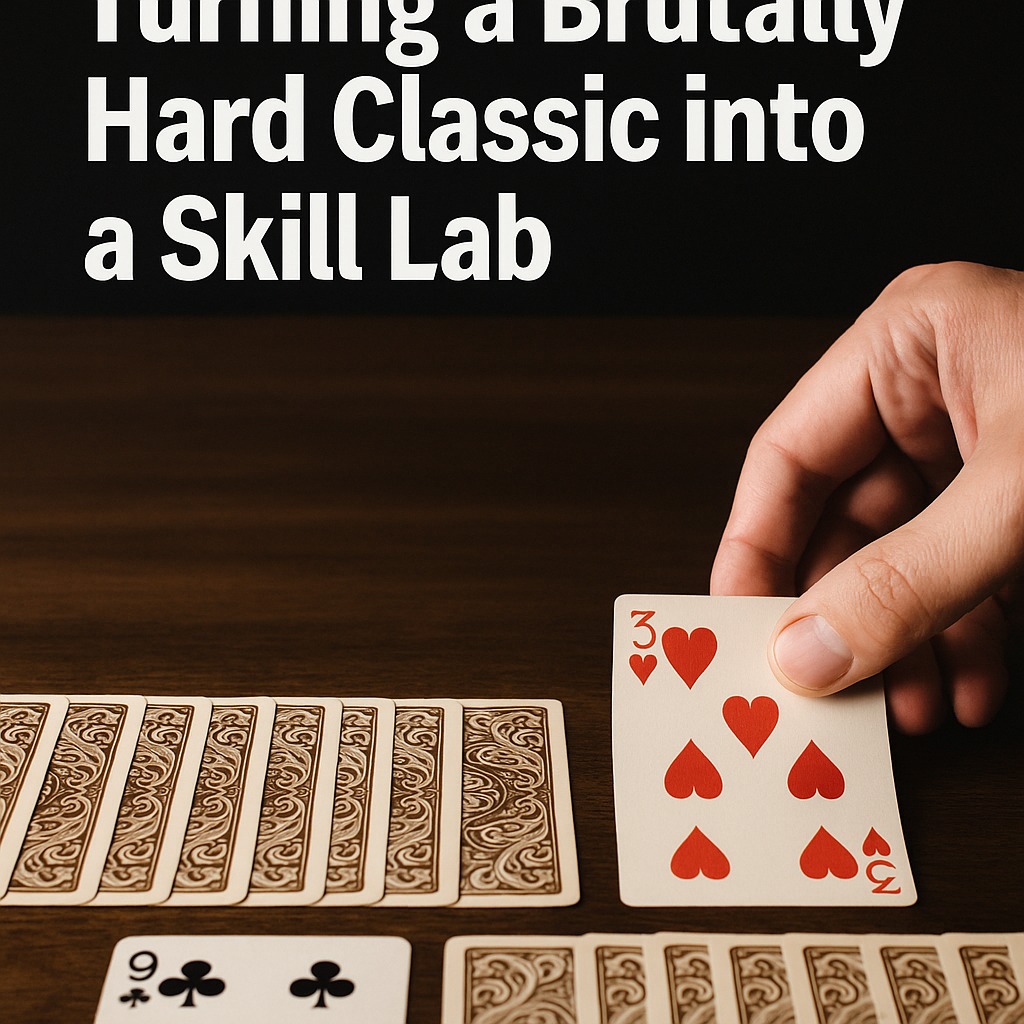Accordion Solitaire: Turning a Brutally Hard Classic into a Skill Lab
The room is still, a single row of cards stretches across your screen, and one clean glide pulls a far‑right pile three places left. The layout breathes. Another merge, then another—until one stubborn gap ends the run. Was there a better moment to jump three left instead of one? What if Accordion—a game many call “unwinnable”—became the most reliable practice arena in your solitaire routine?
What changes when you treat each merge like a measurable experiment instead of a guess? In this guide, you’ll get a crisp refresher on rules, four priority decisions that consistently improve outcomes, a 5‑minute micro drill to sharpen recognition speed, and a tiny analytics sheet to track progress. Open a fresh deal on Solitairen and follow along.
Accordion in 30 Seconds (quick rules refresher)
-
Setup: Deal the full deck into a single row of face‑up piles (one card per pile).
-
Moves: You may merge a pile onto the pile immediately to its left or the pile three positions to its left if the top cards match in rank or suit. After a merge, close the gap by sliding piles left.
-
Goal: Compress everything into a single pile—or get as close as skill (and luck) allow. No redeals.
Four Decisions That Separate Steady Winners from Streaky Runs
-
Prefer 3‑left merges over 1‑left—when they don’t kill future combos.
A 3‑left merge removes more space and often triggers chains. Before you take an available 1‑left, scan the future: Will a 3‑left still be possible afterward? -
Suit beats Rank when tie‑breaking early.
Matching by suit tends to preserve more future rank matches than the reverse. Early in the deal, lean suit; late, switch to whichever option opens the longest sequence now. -
Build “stepping stones.”
If two merges are available, first create a position that unlocks two new matches next. Ask: Which move increases the number of open matches after the board compresses? -
Avoid “happy clicks.”
If you see back‑to‑back 1‑left merges, pause. Can the second become a stronger 3‑left after one compression? Train your eye to look three piles back automatically.
Self‑check:
-
Are you scanning 3‑left first on every look?
-
Do you track how often a 1‑left blocked a future 3‑left in your games?
-
When two choices are equal, do you default to suit over rank?
-
Are you measuring how many merges you get per 30 seconds of focused play?
5‑Minute Micro Drill: “3‑Left First” Recognition
Setup (60 sec): Start a new deal on Solitairen. Set a timer for 3 minutes of play + 1 minute of review.
Run (3 min):
-
Move only when you can articulate the reason out loud: “3‑left over 1‑left,” “Suit over rank,” “Stepping stone.”
-
Each time you take a 1‑left, quickly scan whether a 3‑left would have existed after compression. Note “Y/N”.
Review (1 min):
-
Count merges made; count “lost 3‑lefts” caused by taking a 1‑left too soon.
-
Set a tiny rule for the next session (e.g., “Always scan 5 piles to the left before any 1‑left in the first minute.”).
Repeat this drill across 5–10 games; your recognition speed compounds fast.
Accordion Sabermetrics: Small Numbers, Big Signal
Track just a few metrics—enough to observe real change without bogging down the fun:
-
Merges/Game (MG): total successful merges.
-
3L%: share of merges that were 3‑left (target >35% as you improve).
-
Lost‑3L (L3): times a 1‑left blocked a future 3‑left.
-
Chain Max (CM): longest consecutive merge streak in a game.
-
Compression Index (CI): piles remaining at stop; lower is better.
Example (synthetic data for format only—replace with yours):
| Session | Games | MG (avg) | 3L% | L3 (avg) | CM (avg) | CI (avg) |
|---|---|---|---|---|---|---|
| Week 1 | 12 | 38.2 | 29% | 3.4 | 5.1 | 14.8 |
| Week 2 | 12 | 42.7 | 36% | 2.1 | 6.3 | 12.2 |
| Week 3 | 12 | 45.9 | 39% | 1.6 | 7.0 | 10.5 |
Methodology & workflow (transparent):
-
Fix the ruleset (standard Accordion) and log every game in sessions of 10–12.
-
Use the micro drill for the first 3 minutes of each game to standardize pressure.
-
Review weekly; change one behavior at a time (e.g., stronger suit preference early).
-
Keep notes on memorable board states (“double 1‑left temptation”, “late 3‑left unlock”).
Practical Tips & Common Leaks
-
Early board = information phase. Take merges that reveal more options after compression. If both choices are neutral, pick the one that shifts a high‑value rank (Aces, Kings) nearer to the action.
-
Middle board = ladder building. Aim to create alternating match “rungs” every two to three piles, so a single merge triggers a cascade.
-
Late board = variance control. When few piles remain, prioritize moves that keep two distinct matches open, not just the flashy one.
-
Mindset: Accordion has real variance. Judge success by CI trend and L3 reductions, not only by rare full clears. If you like to play solitaire online free, use quick sessions on Solitairen to gather clean practice data without friction.
Summary & Next Step
Accordion can feel unforgiving—but that’s exactly why it’s the perfect skill lab. By scanning 3‑left first, favoring suit early, and training with a 5‑minute drill, you convert “almost” runs into measurable progress. Track 3L%, L3, and CI for ten sessions and watch the curve bend.
Call to action: Fire up a fresh board on Solitairen, run the drill, and log your next 10 games. What’s the first tiny rule you’ll adopt to cut your Lost‑3L in half this week?
